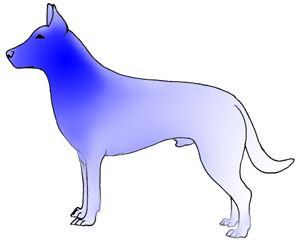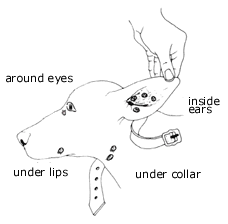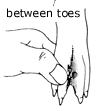TICK ATTACHMENT SITES for Ixodes holocyclus in dogs
This page is based on the article by Atwell RB, Campbell FE and Court E (2000): The Attachment Sites of the Paralysis Tick (Ixodes holocyclus) on dogs, Aust Vet Practit, 30(2)
Introduction
Natural infestation
Experimental Infestation
Theories on Distribution
Tabulated Summary of Attachment Sites
References
Introduction
Bancroft, in 1884, observed that the Australian paralysis tick usually attached "about the head and ears" of dogs (Bancroft, 1884). A recent survey (Atwell et al, 2000) has confirmed that the head and neck account for 70% of attached ticks in both naturally acquired and experimental infestations. This was despite the fact that in the experimental infestations 50 ticks were evenly dispersed along the dorsum (head, neck and back) of each dog. Additionally it was found that significantly more ticks attached to the chest and belly than to the crown, back and flanks, suggesting a preference for attachment to ventral sites.
 |
 |
| The darker blue areas indicate the higher chances of tick attachment (based on data tabulated in: Atwell RB, Campbell FE and Court E (2000): The Attachment Sites of the Paralysis Tick (Ixodes holocyclus) on dogs, Aust Vet Practit, 30(2); image source: NF, 2000. |   |
When searching for ticks on dogs bear in mind that any accessible epithelial surface provides a possible point of attachment. Some of the more unusual sites include: within the mouth, under the tongue, the ear canal (even on the tympanic membrane), the nostril, the anus, the vulva and within the prepuce.
Natural infestation
In a prospective study involving 42 veterinary clinics on the eastern coast of Australia the attachment site of ticks was recorded for the first 13-15 dogs presented to each clinic with tick paralysis (Sept-Nov, 1998) (Atwell et al, 2000).
| Location of ticks- natural infestation | ||
|---|---|---|
Location |
Number of ticks | Percentage of ticks |
| neck | 310 | 39 |
| ears | 80 | 10 |
| jaw/throat | 98 | 12 |
| cheek/nose | 67 | 8 |
| eyes | 38 | 5 |
| crown | 33 | 4 |
| chest/belly | 81 | 10 |
| legs | 56 | 7 |
| tail/anus | 8 | 1 |
| flank/back | 35 | 4 |
| Table 1: Location of 806 ticks following natural infestations in 577 dogs. Ref: Atwell RB, Campbell FE and Court E (2000): The Attachment Sites of the Paralysis Tick (Ixodes holocyclus) on dogs, Aust Vet Practit, 30(2) | ||
Experimental Infestation
Eight hyperimmune Foxhounds of varying age, gender, size, colour and coat length were used. At infestation 50 unfed adult female ticks were evenly dispersed along the dorsum (head neck and back) of each dog. No artificial stimulationwas employed to induce tick attachment. One day later the location of all live ticks (attached and unattached) was recorded using the same body divisions as for natural infestations, and at 3 days all ticks were removed. At 7 days the dogs were again infested with 50 ticks and at days 8, 9 and 10 the location of the ticks recorded, and they were then removed. This procedure was repeated at 7 day intervals for another 5 cycles. Overall each dog was infested 7 times with 50 ticks and these ticks were removed and recorded on 19 occasions (Atwell et al, 2000).
| Tick Loads- experimental infestation | ||
|---|---|---|
Location |
Mean Percentage | Standard Deviation |
| neck | 27.84 | 18.40 |
| ears | 22.95 | 14.67 |
| jaw/throat | 8.04 | 8.18 |
| cheek/nose | 6.03 | 6.43 |
| eyes | 4.43 | 7.02 |
| crown | 2.75 | 4.47 |
| chest/belly | 13.40 | 12.21 |
| legs | 5.76 | 6.26 |
| tail/anus | 6.78 | 8.43 |
| flank/back | 2.03 | 3.20 |
| Table 2: Means of the percentages of individual tick loads at each site from all 19 countsfollowing seven experimantal infestations on eight dogs. Ref: Atwell RB, Campbell FE and Court E (2000): The Attachment Sites of the Paralysis Tick (Ixodes holocyclus) on dogs, Aust Vet Practit, 30(2) | ||
Tabulated Summary of Attachment Sites for both Natural and Experimental Infestations of Ixodes holocyclus in Dogs
 |
| Figure 1: Atwell RB, Campbell FE and Court E (2000): The Attachment Sites of the Paralysis Tick (Ixodes holocyclus) on dogs, Aust Vet Practit, 30(2) |
Theories on distribution
The attachments of paralysis ticks are not random- some kind of attachment site specificity clearly occurs. The question is whether the the specificty is related to the initial contact of tick and host, whether it is a result of tick migration after host contact, or whether it is a result of host removal after host contact. Some of the teleological theories, which may be mutually inclusive, are:
- Bandicoot factors. It is perhaps reasonable to assume that the greatest selection pressure for the evolution of preferred sites comes from factors determined by the natural host, the bandicoot. What these bandicoot-specific factors may be has yet to be shown.
- Tick mating. Tick localisation may provide improved intraspecific contact for a low-density population on the host (Rohde, 1979)
- Tick feeding. Skin may be more attractive to the tick at the preferred sites- more supple for hypostome penetration, or better blood supply for feeding.
- Tick protection. Preferred site may provide protection from host grooming, and/or from external abrasion as the dog moves.
- Tick interspecies competition. This is unlikely in the dog because of the small numbers of ticks present. (Could it be a factor in the bandicoot?- what is the significance of other tick species in bandicoots?) (Holmes, 1973)
- Expired respiratory gases may be attractive to the tick. (Garcia, 1962)
- Host removal. The attachment pattern may to some extent reflect the act of the host detecting and removing or displacing the ticks through normal grooming habits. This could particularly apply to cats for example, where ticks are much more rarely found in groomed areas of the coat. The attachment process thus could still be random but the removal process not. This theory probably offers only a partial explanation of the distribution pattern. One would expect variations according to host species. [NF]
References:
Atwell RB, Campbell FE and Court E (2000): The Attachment Sites of the Paralysis Tick (Ixodes holocyclus) on dogs, Aust Vet Practit, 30(2)
The Paralysis Tick of Australia - Home
E-mail Us to report a broken link!